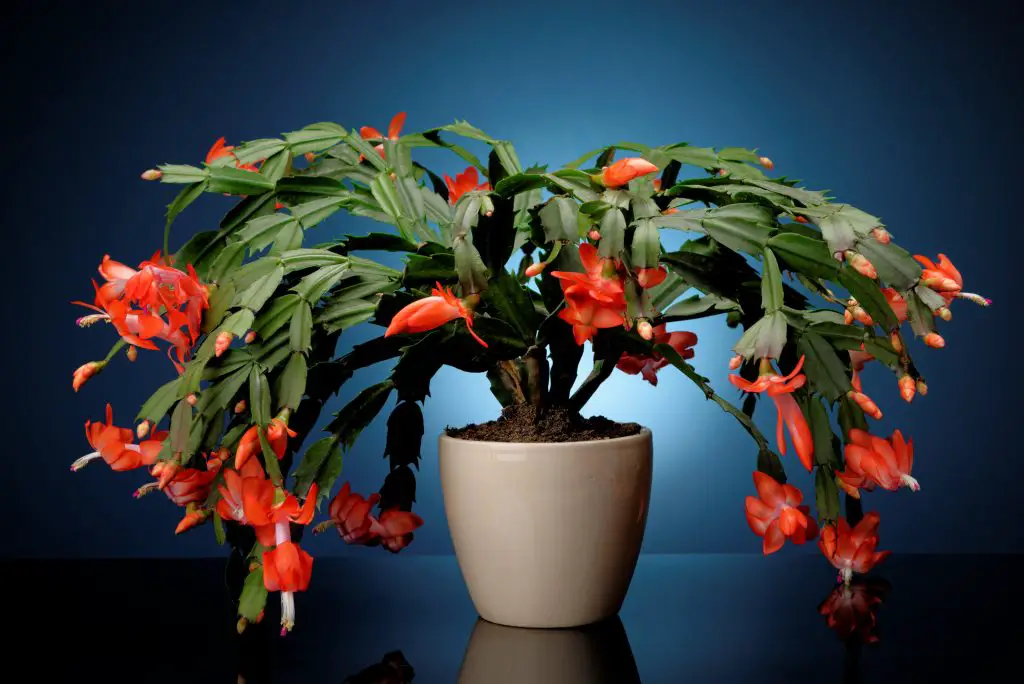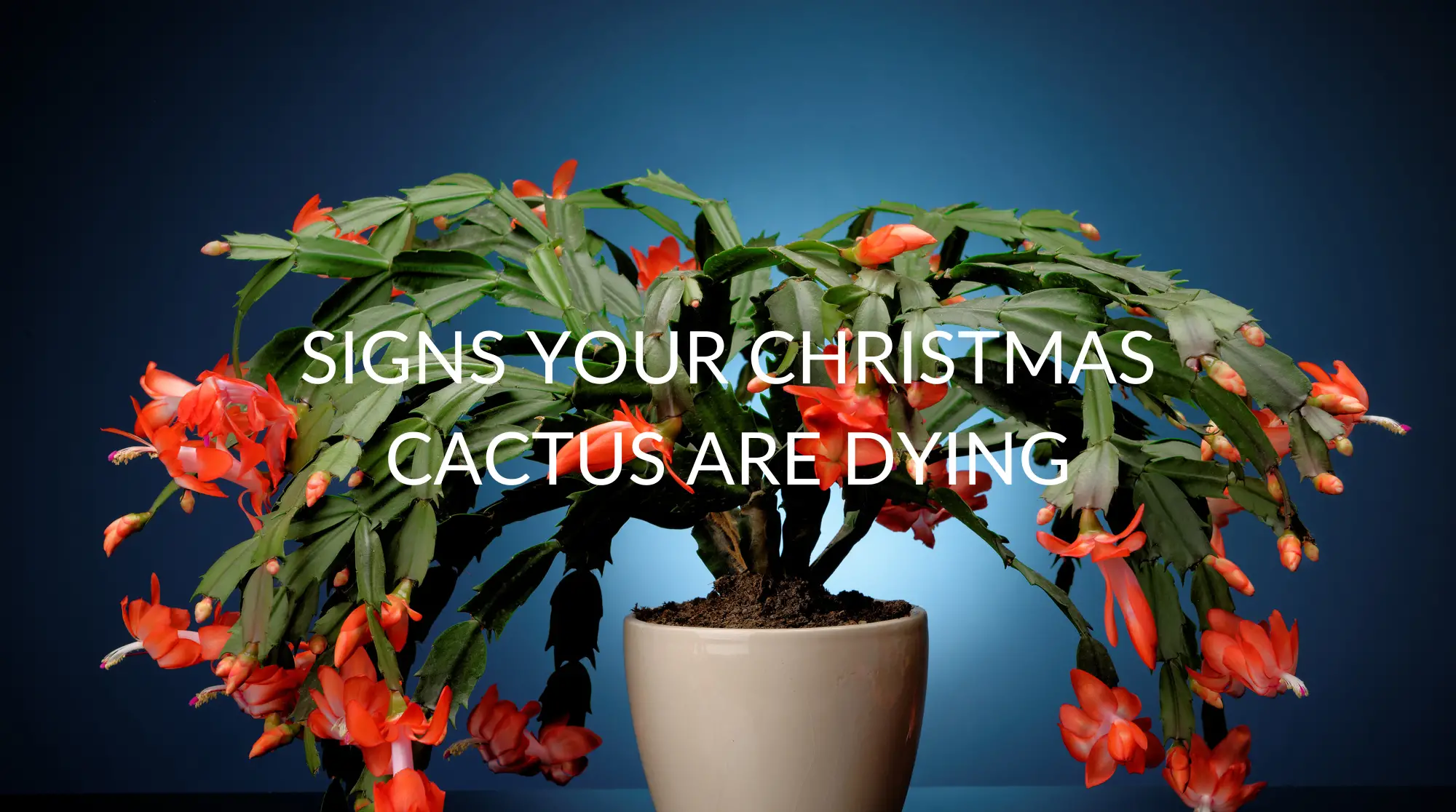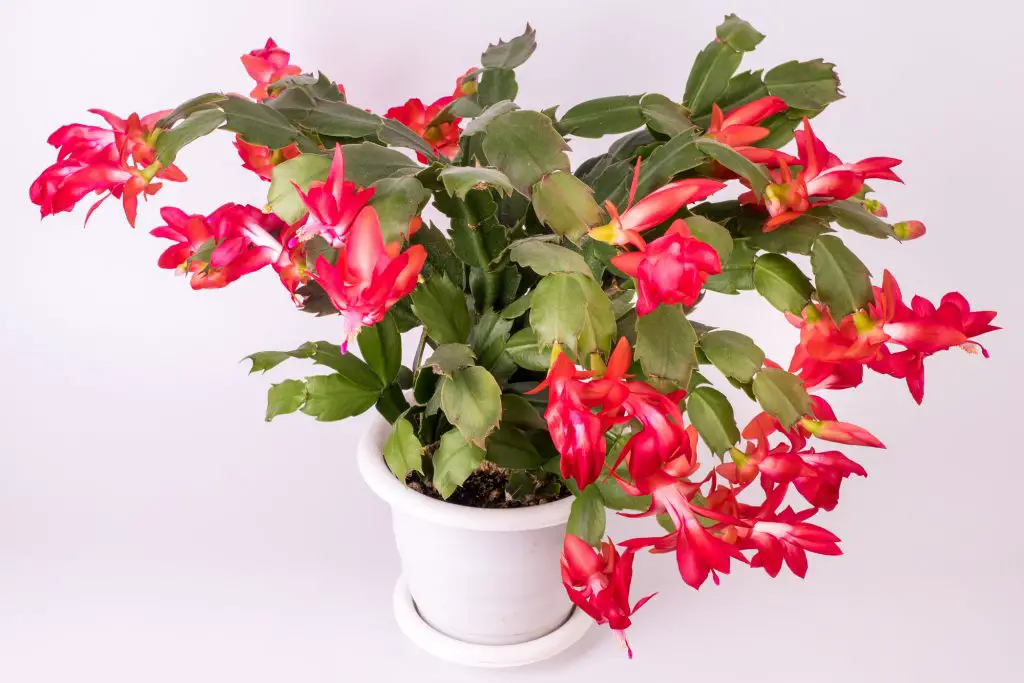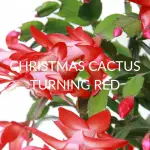Christmas cacti are popular houseplants that bloom during the winter season. According to the Farmer’s Almanac, a Christmas cactus should receive different care than other cactus species that prefer dry, sunny environments. If you’ve noticed that your Christmas cactus doesn’t look as healthy as it used to, you can check for signs your Christmas cactus is dying.
Signs that your Christmas cactus is dying can include yellow leaves, limp foliage, rotting roots, or a plant that doesn’t flower. If you’re concerned that your cactus might be dying, the good news is that there are easy ways to identify the issue and help your plant thrive again.
Discover these common reasons that can cause your Christmas Cactus to die and how to fix the problem.
What is the Lifespan of a Christmas Cactus?
With white, pale pink, hot pink, salmon, or deep crimson flowers, a healthy Christmas cactus can survive for decades. With proper care, a Christmas cactus can even live up to 100 years.
According to a 2009 article in the Bozeman Daily Chronicle, the Kent family’s 3-foot-tall, 3-foot-wide Christmas cactus dates back 145 years to a great-great-great-grandmother who brought the plant with her on her journey west to homestead in Montana in 1863. In Bismarck, North Dakota, a Christmas cactus estimated to be 111 years old sits on display at a local Seventh Day Adventist church office.
Despite the name, Christmas cacti are not true cacti. They are a type of succulent. This means that they aren’t desert-loving plants that thrive in hot, dry conditions. A Christmas cactus is an epiphyte from the genus Schlumbergera. They originally grew in the cracks of tree branches in Brazil’s shady, tropical rainforests.
Signs Your Christmas Cactus is Dying
1. Its Leaves or Roots Look Black
Black or slimy roots are a warning sign. It means that your Christmas cactus’ root system is rotting. This can indicate that your plant is overwatered. It can also mean that your plant has a disease.
Overwatering can also cause a Christmas cactus’ roots to rot. If rotting roots are left untended for too long or if the soil is always saturated, fungal issues and decay can set in.
2. It Has Pale or Yellow Leaves
Have you spotted yellow on your Christmas cactus? Maybe it doesn’t have succulent green leaves anymore. This can mean that your Christmas cactus is in trouble. Yellow leaves indicate that your plant is dying from a lack of sunlight.
If your plant has turned pale or the green color is fading, your plant isn’t getting the light it needs to go through the photosynthesis process.
Check if your room is too dark or if the plant is in a corner where it can’t receive sun. While Christmas cacti can’t take the direct sun, they still need hours of indirect light every day.

3. It Looks Limp
It’s a sure sign that something is wrong if you catch your Christmas cactus drooping over its pot. You might notice that the plant also collapses.
That’s an indicator that the plant stem and root system have weakened and collapsed. This can be due to a couple of issues. One of the most likely culprits is too much watering which can cause roots to collapse.
4. It’s Losing Its Leaves
If you notice that your Christmas cactus is looking a little bare or missing foliage, pests are a common culprit. Gnats, aphids, and mealybugs attack houseplants. Unfortunately, the Christmas cactus is at risk from various diseases and pests that can invade your home and harm or kill your plant.
Aphids and gnats strip foliage, while mealybugs can destroy the cactus’ root system. If the plant survives, it might look stunted or have slow growth.
5. It’s Stopped Growing or Flowering
Floppy leaves or poor growth are a sign that your Christmas cactus is in trouble. This can indicate that your plant is dying due to a lack of nutrients in the soil.
Your Christmas cactus’ life depends on extracting the right macro and micronutrients from the soil in which it lives.
If your cactus is only a year or two old, there’s no need to add extra nutrients since the plant will receive what it needs from the fertilized soil that existed when you bought the plant. Over time, the plant consumes all the nutrients from the soil. When this happens, there’s nothing left to help the plant survive.
When a Christmas cactus is confined to a pot, there’s no way to replenish depleted nutrients. If the cactus is watered regularly, this also washes away nutrients the plant depends on.
6. It Dies in Winter
Despite their festive name, Christmas cacti are tropical plants that enjoy a warm, humid climate. If your Christmas cactus is planted outside instead, you might notice that your cactus doesn’t survive the winter.
This might occur if you live in a climate that’s too cold for a Christmas cactus. According to the United States Department of Agriculture (USDA), a Christmas cactus can only live outdoors through winter in U. S. zones 9-11.
Most Christmas cacti are warm-weather lovers that thrive in moderately warm conditions. Bring your Christmas cactus indoors before the first frost hits to keep it from dying from cold.
Why is My Christmas Cactus Dying?
According to Country Living magazine’s gardening experts, there are several reasons why your Christmas cactus might look like it is dying. If your Christmas cactus has turned brown, black or looks decayed, it’s important to act fast.
While it can be a little tricky to keep your plant healthy, it just takes some tweaking to figure out what is causing the issue and restore it to a vibrant state.
Underwatering
If your plant is wilting and pale, this can mean that your cactus isn’t getting enough water. Because a Christmas cactus isn’t a true cactus, it can’t go weeks without water like its desert relative.
A Christmas cactus has fleshy leaves like succulents that allow the plant to retain some water. At the same time, they need moist soil to avoid dying. A lack of water will prevent the plant from absorbing nutrients from the soil. The cactus’ cells also will weaken and cause the plant to collapse.
If you notice that your cactus is shriveling up, check the soil’s dampness. Don’t let the soil dry out between watering times. If the soil is too dry and water just sits on top of it, you can poke holes in it with a sharp object like a skewer to allow the water to filter through to the plant’s roots.
Make sure that your cactus isn’t planted in rocks instead of potting soil. Rocks can cause too much drainage, which can make water flow away from the cactus’ root system and cause dehydration.
Overwatering
Another sign that your Christmas cactus is dying is if the plant turns limp and the foliage starts to collapse over the side of the pot. Over time, the leaves can rot and fall off. Roots may look black and waterlogged. This is a sign that your plant may be getting too much water.
Most Christmas cacti need watering every 1-2 weeks. If your plant is too dry or if you’ve accidentally overwatered it, spritz the plant with water every couple of days until the soil retains a slightly moist texture.
Pests
Bugs such as aphids, mealybugs, and gnats destroy and spread disease among houseplants. The best way to protect your Christmas cactus from pests and prevent any further damage is to get rid of the bugs right away.
You can mix up a safe insecticide at home or spray neem oil on your Christmas cactus to deter pests and protect the plant’s leaves and root system. Spray a couple of times for a week or two to ensure that any bugs hiding under leaves or burrowed in the soil are gone.
How Can I Help My Dying Christmas Cactus?
1. Provide Enough Indirect Light
A Christmas cactus, like other houseplants, needs a routine that follows natural seasonal rhythms of light and darkness. For example, Christmas cacti need some dark times during autumn to trigger those Christmas flowers that most owners look forward to seeing.
Keep your Christmas cactus in the full, indirect sun all day. While the plant can tolerate low light at night during most of the year, keep your cactus in total darkness at night during autumn to trigger its normal flowering cycle.
Keep in mind that too much sunlight can cause leaves to turn red, purple, or look scorched. If you notice this sign, transfer your plant to a place with less harsh sunlight.
2. Water Lightly and Regularly
While a Christmas cactus isn’t a normal cactus and loves damp, humid conditions, it’s important not to overdo it when it comes to watering. Don’t saturate the soil with water every day.
On the other hand, don’t let it become dry and compact. Too much water rots roots and washes away nutrients. Forget to water your cactus for weeks, and your plant will struggle to absorb nutrients from the soil.
Balance is key. Spray the soil with water every week or two to keep it moist.
3. Add Some Fertilizer
If your plant is more than 1-2 years old, it’s time to add some nutrients to the soil. The great thing about a Christmas cactus is that it isn’t very dependent on fertilizer and doesn’t need constant applications like some other types of houseplants.
You can check the soil’s pH before adding extra fertilizer to make sure that a lack of nutrients is causing the problem. If the soil is in good shape, add a balanced fertilizer formula for houseplants about once every month from spring through autumn.
4. Remove Dead or Rotten Roots
If your Christmas cactus has turned brown, black, or slimy, then you’ll need to go to work to remove rotten plant parts. It’s important to cut off any soggy plant matter or rotten roots right away. Make sure to use a clean, sterilized pair of scissors to avoid spreading disease to healthy areas of the plant.
Remove the trimmed plant and repot it in fresh potting soil. This will prevent any bugs or diseases in the old soil from further damaging your Christmas cactus.
5. Create Humidity
As tropical epiphytes that once lived under rainforest canopies, Christmas cacti thrive in a humid environment. If your watering routine is perfect and your plant still seems like it is lacking water, your room might be too cold or dry.
Try adding a humidifier or cool air mister to the room to mimic a jungle atmosphere and coax flowering and growth. Keep daytime temperatures at 70 degrees F and no lower than 60 degrees F at night.
6. Repot It
If your plant has lived in the same pot for a few years and the soil has broken down, it’s probably time to repot the plant.
While a Christmas cactus’ roots need some crowding to encourage flowering, it’s best not to leave the plant in cramped conditions for an extended time. A rootbound cactus uses up all its available space to grow. Roots tangle, twist around the pot or start sprouting through soil or pot drainage holes.
This is a clear sign to repot the plant right away. Overcrowded roots can’t absorb water or nutrients well. If you notice your plant isn’t growing or it seems nutrient deficient even though you’re doing everything right, it’s time to move your cactus to a new pot home.
Final Thoughts
Christmas cactuses are festive plants that bring joy to the cold winter season. It can be a major letdown when your Christmas cactus starts dying. The good news is that with a little work, you can reverse root or leave damage to promote a healthy plant.
Sometimes the fix is as easy as adjusting your watering habits or adding the right fertilizer to the soil. At other times, you might need to spray for bugs, cut away dead and rotting roots, or rehome your plant in a bigger pot to give it space to grow.
With proper watering, adequate sunlight, pest protection, repotting, and good nutrition, your Christmas cactus can live to a ripe and healthy old age.








